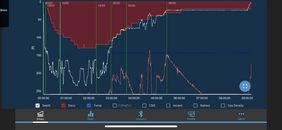GF99/99
Contributor
I know there are a few previous discussions about oxygen toxicity but I thought I would start one about what others consider an acceptable level or risk for CNS/OTU levels
At an advanced (key word here is advanced so please lets not flame away about going over 80% lets try and have a serious discussion) technical level of diving I think we all know that the days when you took your first PADI nitrox course and were scared into the magical 80% max CNS level is a conservative number intend for the typical holiday family diver.
So my question is those that are diving over 80% how far do you push it? What are you comfortable with and why? Same for OTU's
Over the years I have tied to read a decent amount of info on oxygen toxicity and its is one of those things that I always have in the back of my head but also it is something that has sooooo many variables it is virtually impossible to put an acceptable value on that is not super conservative. But that being said I have not found alot of info about what levels actual divers underwater are reaching and what the outcomes were.
Additionally what are your thoughts on air brakes and how effective do you think they are?
At an advanced (key word here is advanced so please lets not flame away about going over 80% lets try and have a serious discussion) technical level of diving I think we all know that the days when you took your first PADI nitrox course and were scared into the magical 80% max CNS level is a conservative number intend for the typical holiday family diver.
So my question is those that are diving over 80% how far do you push it? What are you comfortable with and why? Same for OTU's
Over the years I have tied to read a decent amount of info on oxygen toxicity and its is one of those things that I always have in the back of my head but also it is something that has sooooo many variables it is virtually impossible to put an acceptable value on that is not super conservative. But that being said I have not found alot of info about what levels actual divers underwater are reaching and what the outcomes were.
Additionally what are your thoughts on air brakes and how effective do you think they are?






